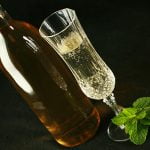Homemade Mint Wine Recipe
This is a light, sweet, unique wine.. great served chilled. If you have some patience, you’ll be glad you stuck it out. This wine ferments lightly and sloooowly.
Other than that, mint is easy to make, and SUPER cheap if you – like a lot of people I know – have a patch of mint that’s bent on taking over your yard. A great summer project!
Servings: 1 gallon
Calories: 5424kcal
Equipment
- Large pot
- 2 gallon fermenter bucket and lid
- 1 - 2 1 gallon glass carboys & stoppers
- 1 air lock and stopper
- Siphon, siphon tubing.
Ingredients
- 5 cups Fresh Mint washed and packed
- 1 gallon Water
- 3 lbs Granulated Sugar
- ¼ teaspoon Wine Tannin
- 1 teaspoon Acid Blend
- 1 teaspoon Yeast Nutrient
- 1 packet Red Star “Champagne” brewing/wine yeast
Instructions
- Place mint in a large pot, add as much water as will fit in the pot (while still allowing for mashing!). Bring to a boil, remove from heat, steep for an hour.
- Strain out mint leaves, pressing well. Reserve leaves. Add sugar to mint water, bring to a boil once again, stirring until sugar dissolves. Remove from heat, cover with sanitized pot lid.
- Once mixture has cooled to room temperature, add wine tanning, acid blend and yeast nutrient. Using a sanitized funnel, transfer cooled mixture to a sanitized 1 gallon carboy.
- If you weren’t able to get a full gallon of mint “tea” out of the first batch, cover reserved mint leaves (or fresh ones, if you have plenty to spare!) with more water, and repeat – without adding any more sugar or additives. Use fresh mint/water mixture to top up the liquid in the carboy, until it’s almost full.
- Using sanitized equipment, take a gravity reading. Keep track of the number! (This is an optional step, but will allow you to calculate your final ABV %)
- Sprinkle yeast into (fully cooled!) carboy, cover with sanitized air lock. Let sit, undisturbed, overnight.
- Within 48 hours, you should notice a little fermentation activity – bubbles in the airlock, carbonation and /or swirling in the wine must. This means you’re good to go! Put the carboy somewhere cool (not cold!), and leave it alone for a month or two.
- Using sanitized equipment, rack the clarified wine off the sediment, into a clean, freshly sanitized 1 gallon carboy. Cap with sanitized airlock, leave it alone for another 2-3 months.
- Repeat racking process every few months. By 1 year in, your wine should be very clear, and VERY tasty!
- When your wine has been racked a few times and shows NO more fermenting activity for a month or so (no bubbles in the airlock, no more sediment being produced, you can move on to bottling:
- Using sanitized equipment, take a gravity reading, then rack the wine into clean, sanitized bottles. Cork, allow to age in a dark place for a year.
- Serve chilled.
Notes
IMPORTANT:
Software generates nutritional information based on the ingredients as they start, and is unable to account for the sugars consumed in the fermentation process. As such, the calories, sugars, and carbs are shown WAY higher than reality.
Additionally, the listed value is for the entire recipe, NOT per serving.
Nutrition
Calories: 5424kcal | Carbohydrates: 1394g | Protein: 8g | Fat: 2g | Saturated Fat: 1g | Sodium: 273mg | Potassium: 1280mg | Fiber: 18g | Sugar: 1358g | Vitamin A: 9558IU | Vitamin C: 72mg | Calcium: 674mg | Iron: 12mg
